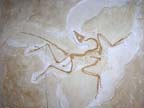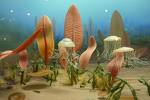 |
 |
 |
 |
 |
Produced
by the Population Genetics and Evolution class, Furman University |
||||
 |
 |
 |
 |
 |
Produced
by the Population Genetics and Evolution class, Furman University |
||||
 |
The
Ediacaran: Pteridinium |
 |
Very little is known about the origins and behavior of Pteridinium. Its fossils are found in Russia, Australia, Namibia and in Stanly County, North Carolina. According to the University of California Museum of Paleontology, Pteridinium possessed “an elongated, ribbed body that is usually found squashed flat” and “three ribbed ‘leaflets’ which met along the central midline” (Collins et al., 2006). It is generally found with its lobes flattened as a result of being buried (Mayer and Harries, 2008). Its taxonomy is rather ambiguous; it has been suggested to be related to Phylum Cnidaria, but it would have to be a very distant relative. A member of the Ediacaran biota, its interaction and/or relation to other known Ediacaran organisms is also indistinct. There is some debate as to whether it originates from the Pre-Cambrian or Cambrian period, but the general consensus is to the former, especially as most known fossils are made of an undisturbed impression in sediment. Proliferating floor activity during the Cambrian period would have prevented the preservation of these fossils (Rowan, 2007). Page by Tory Grimm-Oropesa |
 |
| Photo credit: Pteridinium fossil. (Rowan, 2007). | |
| Collins,
A. G., Waggoner, B. M., Speer, B.R. 2006. Vendian Animals: Pteridinium.
University of California Museum of Paleontology. Accessed January 2010.
Mayer, M., and P. Harries.2008. New insights into Pteridinium morphology using geometric morphology. Abstract, 2008 Interational Geological Congress, Oslo, Norway.Accessed January, 2010. Rowan, C. 2007. Namibia: Precambrian fossils. Scienceblogs.com. Accessed January, 2010. |